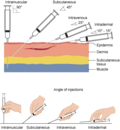Injection (medicine)
Injection (medicine)
An injection is a method of delivering drugs or vaccines directly into a patient's body using a needle and syringe. This method bypasses the digestive system, allowing for immediate absorption of the substance into the bloodstream.
Types of injections[edit]
There are several types of injections, each targeting a different layer of the skin or tissue. These include:
- Intradermal injection: This type of injection is administered into the dermis, or the outermost layer of skin.
- Subcutaneous injection: This injection is given into the fatty layer of tissue just beneath the skin.
- Intramuscular injection: This injection is delivered into a muscle, allowing for faster absorption into the bloodstream.
- Intravenous injection: This injection is administered directly into a vein, providing immediate delivery of the substance into the bloodstream.
Procedure[edit]
The procedure for administering an injection varies depending on the type of injection and the specific medication being delivered. However, the general steps include:
- Preparing the injection site with an antiseptic to prevent infection.
- Inserting the needle at the correct angle and depth for the type of injection.
- Delivering the medication by slowly pushing the plunger of the syringe.
- Removing the needle and applying pressure to the injection site to prevent bleeding.
Risks and complications[edit]
While injections are generally safe, they can sometimes lead to complications such as:
- Pain at the injection site
- Infection
- Allergic reaction
- Bleeding or bruising
- Nerve damage
Patients should always consult with their healthcare provider before receiving an injection to discuss potential risks and benefits.
See also[edit]
-
Drawing of syringes with needle
-
Needle insertion angles
-
Mantoux tuberculin skin test
Ad. Transform your life with W8MD's Budget GLP-1 injections from $75


W8MD offers a medical weight loss program to lose weight in Philadelphia. Our physician-supervised medical weight loss provides:
- Weight loss injections in NYC (generic and brand names):
- Zepbound / Mounjaro, Wegovy / Ozempic, Saxenda
- Most insurances accepted or discounted self-pay rates. We will obtain insurance prior authorizations if needed.
- Generic GLP1 weight loss injections from $75 for the starting dose.
- Also offer prescription weight loss medications including Phentermine, Qsymia, Diethylpropion, Contrave etc.
NYC weight loss doctor appointmentsNYC weight loss doctor appointments
Start your NYC weight loss journey today at our NYC medical weight loss and Philadelphia medical weight loss clinics.
- Call 718-946-5500 to lose weight in NYC or for medical weight loss in Philadelphia 215-676-2334.
- Tags:NYC medical weight loss, Philadelphia lose weight Zepbound NYC, Budget GLP1 weight loss injections, Wegovy Philadelphia, Wegovy NYC, Philadelphia medical weight loss, Brookly weight loss and Wegovy NYC
|
WikiMD's Wellness Encyclopedia |
| Let Food Be Thy Medicine Medicine Thy Food - Hippocrates |
Medical Disclaimer: WikiMD is not a substitute for professional medical advice. The information on WikiMD is provided as an information resource only, may be incorrect, outdated or misleading, and is not to be used or relied on for any diagnostic or treatment purposes. Please consult your health care provider before making any healthcare decisions or for guidance about a specific medical condition. WikiMD expressly disclaims responsibility, and shall have no liability, for any damages, loss, injury, or liability whatsoever suffered as a result of your reliance on the information contained in this site. By visiting this site you agree to the foregoing terms and conditions, which may from time to time be changed or supplemented by WikiMD. If you do not agree to the foregoing terms and conditions, you should not enter or use this site. See full disclaimer.
Credits:Most images are courtesy of Wikimedia commons, and templates, categories Wikipedia, licensed under CC BY SA or similar.
Translate this page: - East Asian
中文,
日本,
한국어,
South Asian
हिन्दी,
தமிழ்,
తెలుగు,
Urdu,
ಕನ್ನಡ,
Southeast Asian
Indonesian,
Vietnamese,
Thai,
မြန်မာဘာသာ,
বাংলা
European
español,
Deutsch,
français,
Greek,
português do Brasil,
polski,
română,
русский,
Nederlands,
norsk,
svenska,
suomi,
Italian
Middle Eastern & African
عربى,
Turkish,
Persian,
Hebrew,
Afrikaans,
isiZulu,
Kiswahili,
Other
Bulgarian,
Hungarian,
Czech,
Swedish,
മലയാളം,
मराठी,
ਪੰਜਾਬੀ,
ગુજરાતી,
Portuguese,
Ukrainian



